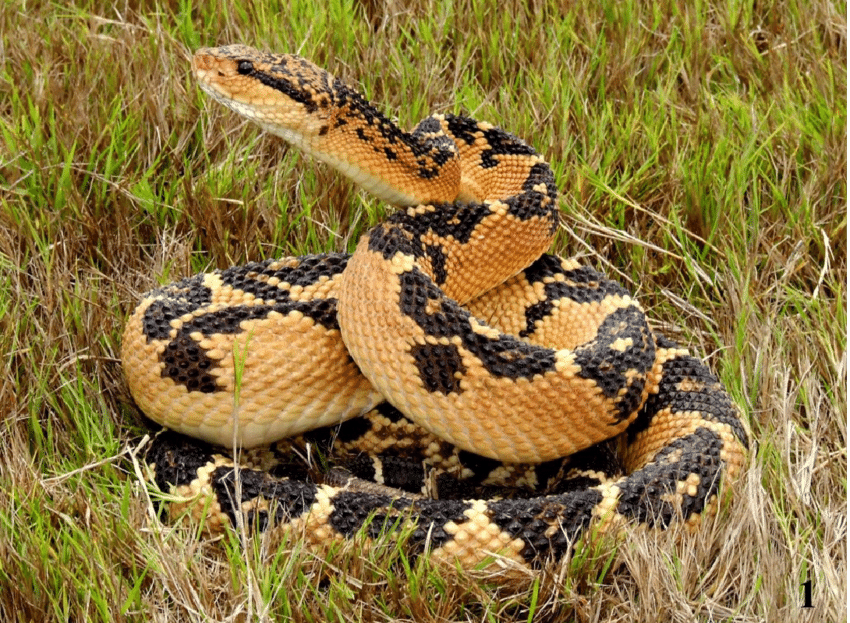
Lachesis mutus
Latin name: Lachesis mutus
Short name: Lach
Common name: Bushmaster snake | Surucucú | Mute serpent | Lachesis viper | South American pit viper
Primary miasm: Syphilitic Secondary miasm(s): Sycotic, Psoric
Kingdom: Animals
Family: Viperidae
- Symptomatology
- Remedy Information
- Differentiation & Application
Lachesis mutus is a venomous snake native to Central and South America. Its venom is derived from the largest known species of pit viper, which can exceed 3 metres in length. The venom is haemotoxic, affecting the blood and vascular system, and contains potent enzymes that promote bleeding, necrosis, and inflammation. In homeopathy, the venom is attenuated through potentisation, revealing its deep-acting potential for mental, circulatory, and hormonal disorders.
In toxicology, the venom has been studied for its ability to induce haemorrhage, clotting disorders, and tissue destruction. Traditional South American medicine recognised its deadly effects, and modern research into pit viper venom has explored its applications in anticoagulant drug development.
First proved by Dr. Constantine Hering in 1828 using his own arm for inoculation and careful observation. Symptoms were later confirmed and expanded by numerous classical homeopaths, including Kent, Hering, and Allen.
Lachesis acts with extraordinary intensity on the circulatory system, especially the venous blood, producing symptoms of congestion, haemorrhage, and ecchymosis. It has a marked influence on the nervous system, generating hypersensitivity, loquacity, restlessness, and mania. Its effects on the throat, particularly the left tonsil, are well-known, with purplish swelling and ulceration. It shows great action on the female reproductive system, influencing menopause, menstruation, and ovarian pathology. The skin is another prominent site, especially in cases involving bluish discolouration, ulcers, or gangrene. It also targets the larynx, heart, liver, and left side in general.
- Discharges (menstrual, nasal, suppurative)
- Cold applications
- Open air
- Sitting up in bed
- Sleep (initially)
- Sleep and immediately on waking
- Pressure, even slight touch
- Warmth, especially warm weather or a warm room
- Alcohol
- Left side or moving from left to right
- Suppressed discharges
- Constriction (tight collars, waistbands)
- Sulphur – Also worse from heat and during sleep but less hypersensitive and less congestive.
- Pulsatilla – Emotional and hormonal but lacks the intensity and left-sided affinity of Lachesis.
- Belladonna – High fever and congestion but less loquacious and lacks the syphilitic features.
- Phosphorus – Haemorrhagic tendencies but more open, affectionate, and right-sided.
- Sepia – Menopausal complaints with indifference, but less jealous and more chilly.
- Complementary: Sulphur, Natrum muriaticum
- Antidotes: Nux vomica, Belladonna
- Inimical: Acetic acid
- Follows Well: Hepar sulph., Carbo veg.
- Precedes Well: Phosphorus, Lycopodium
Lachesis mutus represents intensity, oversensitivity, and suppression. The patient is often excitable, mentally restless, suspicious, and talkative, yet burdened by internal repression. It is the archetypal remedy for conditions where venous congestion, left-sided inflammation, or suppressed discharges cause pathology. The serpent symbolism pervades the remedy: reactive, sensitive to slightest touch or pressure, yet striking out in unpredictable ways. It suits hormonal transitions—especially menopause—and conditions of circulatory excess, mental disturbance, and haemorrhagic risk. It brings great relief when discharges return or pressure is released.
Lachesis is indispensable in menopausal women with hot flushes, mood swings, and congestive headaches, especially when aggravated by heat or pressure. It is a foremost remedy in left-sided sore throats, particularly when swallowing liquids is easier than solids. In circulatory crises—such as stroke, haemorrhage, or collapse—it can act rapidly. It is also useful in chronic suppressed discharges, such as menses or lochia, that lead to mental or cardiac symptoms. Its sphere includes alcoholism, jealousy, loquacity, and skin eruptions that ulcerate and turn purple. Always consider in hypersensitive
In acute conditions, such as left-sided tonsillitis or congestive headache, Lachesis may be prescribed in 30C to 200C, often repeated every few hours at the onset, then spaced out. For menopausal complaints, heart symptoms, or deep emotional suppression, higher potencies—200C to 1M—are frequently indicated, often given once or twice weekly. Hypersensitive patients may require lower potencies or less frequent dosing to avoid aggravation. In chronic cases with miasmatic complexity, Lachesis may act powerfully at the 1M or 10M level under close observation.
Mind
- Loquacity, jumps from one subject to another
- Jealousy, suspicion
- Worse on waking
Throat
- Left-sided sore throat
- Ulcers, dark purplish
- Swallowing solids painful, liquids easy
Female
- Menses suppressed, complaints from
- Menopause, hot flushes, palpitations
- Ovarian pain, left side
Generalities
- Worse from sleep
- Worse from pressure
- Left-sided symptoms
Hering – Guiding Symptoms: Original prover and extensive chronic symptomatology
F. Allen – Encyclopaedia: Detailed repertorial analysis and confirmed provings
T. Kent – Lectures: Psychological and constitutional emphasis on loquacity and suppression
John Clarke – Dictionary: Practical clinical applications and differentiations
William Boericke – Pocket Manual: Essential keynote insights and remedy relationships
Materia Medica Pura (fragmentary) – Referenced historically for venomous symptom parallels
